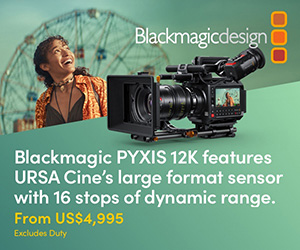Industry Insights: Cinema cameras bring depth and drama to live broadcast

Weekly insights on the technology, production and business decisions shaping media and broadcast. Free to access. Independent coverage. Unsubscribe anytime.
Once reserved for film sets, cinema-style cameras are now redefining how live broadcasts look and feel.
In this Industry Insights roundtable, manufacturers explore why large-sensor, shallow–depth-of-field imagery has become a signature of modern sports, entertainment and event coverage.
As audiences crave more immersive and cinematic storytelling, broadcasters are blending the artistry of film with the immediacy of live television — using cinema cameras to add dimension, emotion and visual prestige. The discussion examines how teams are managing color workflows, adapting live infrastructure for RAW and LOG outputs and balancing creative flexibility with the technical precision required for broadcast consistency. What emerges is a clearer view of how “film look” production has evolved from novelty to necessity.
Continue exploring this Industry Insights series with discussions on studio cameras, PTZ cameras and camera robotics.
Key takeaways from this Industry Insights roundtable
- Filmic aesthetics in focus: Broadcasters are adopting large-sensor cameras to achieve shallow depth of field and cinematic separation once exclusive to film.
- Live color management: Applying LUTs and ensuring consistent grading are essential to integrating cinema cameras into real-time broadcast workflows.
- Creative storytelling: Directors use cinematic visuals to heighten emotion, isolate subjects, and align with the evolving visual expectations of audiences.
- Technical adaptation: Purpose-built “film look for live” systems bridge cinema-style imaging with the speed, control, and reliability of live broadcast pipelines.
- Evolving standards: The fusion of cinema and broadcast technologies is redefining both viewer expectations and production design strategies.
What specific demands have led broadcasters to increasingly adopt cinema-style cameras?
Hiroto Kato, VP, imaging products and solutions, business planning and strategy, Canon: Broadcasters have increasingly adopted large-sensor, cinema-style cameras for creative and technological reasons. Visually, a cinema look is attention-grabbing and offers a prestige quality to a broadcast that we feel that audiences now expect, even in productions such as live sports. Broadcasters are always looking to provide new camera angles and filmic, shallow depth of field looks to their productions. Often, cinema cameras, with a small form factor, are able to deliver those unique point-of-view looks.
Klaus Weber, director product marketing, Grass Valley: The primary reason for using cinema cameras in live applications is to achieve the shallow depth-of-field look, which was previously available mainly with large-sensor cinematic cameras. Other characteristics of digital cinematography cameras — such as lower, filmic frame rates and RAW or LOG outputs intended for post-production — have typically been irrelevant or even disruptive to live production workflows.
How do broadcast teams manage color grading workflows associated with cinema cameras in live production?
Klaus Weber, director product marketing, Grass Valley: This is one of the key concerns when using cinematic cameras in live productions today. Since these cameras are not designed for live production workflows, their intended image look is typically applied during post-production. In live scenarios, a fixed LUT is often applied to the RAW or LOG outputs to approximate the color and tonal characteristics of a traditional live camera. However, live production camera systems offer a wide range of real-time controls to adjust and fine-tune the image — capabilities that go far beyond what a fixed LUT applied to a RAW or LOG signal can achieve.
How have cinematic cameras impacted creative decisions in live broadcasts, such as sports or entertainment shows?
Hiroto Kato, VP, imaging products and solutions, business planning and strategy, Canon: In specific use cases like professional sports, the cinema style feels like it matches the cultural influence of sports and where sports are headed — fans want cinematic, documentary-style content about the players on and off the field, not just studio analysis. A specific visual trend that has expanded in sports in recent years is leveraging shallow depth of field to isolate players, coaches and fans from other subjects in the frame and give them a sense of depth and dimension. At NAB this year, Canon unveiled a new optical unit that integrates with our field box lenses (UHD-Digisuper 122 and UHD-Digisuper 111) that beautifully enhances the subject, even in fast aperture.
What technical adaptations are required when using cinema cameras within traditional broadcast environments?
Klaus Weber, director product marketing, Grass Valley: For the best results, a dedicated “Film Look for Live” camera system is recommended. Instead of adapting a digital cinematography camera by adding live processing and transmission capabilities, it is more effective to integrate a “cinema-style” Super 35 (S35) imaging front end — along with compatible PL-mount lenses — into an existing live production camera system. Such a solution provides the same processing features and color reproduction across all cameras used in the live production.




tags
Camera, Cameras, Canon, Digital Cinema Cameras, Grass Valley, Hiroto Kato, Klaus Weber
categories
Broadcast Equipment, Cameras, Featured, Industry Insights, Voices